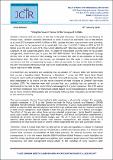Tilting The Scale in Favour of Borrowing And it’s Risks

View/
Date
2020-01-15Author
Jesuit Centre for Theological Reflection
Type
StatementLanguage
enItem Usage Stats
42
views
views
10
downloads
downloads
Abstract
The paper talks about the rise of Zambia’s external debt over the past few years. According to the Ministry of Finance data, Zambia’s domestic debt stock in terms of securities and bonds rose in 2011. Against this back drop and even more alarming, over the years, is the component of external debt that rose. The current debt-to-GDP ratio thus stands at over 50% of GDP. Cognizant of the burgeoning public debt, its negative implications and the need for its prudent management, Government put in place the 2017-2019 Medium Term Debt Management Strategy (MTDS). One of the intents of the strategy was to reduce the rate of accumulation of foreign denominated debt. But what the country has witnessed over the years is rising external debt contraction and the corresponding increase in interest payments. In view of this state of affairs, the 2017 International Monetary Fund (IMF) Debt Sustainability Analysis (DSA) indicated that Zambia was at high risk of debt distress. JCTR advises for transparency in debt contraction and prudent utilization of debt resources to avert unnecessary debt burden on Zambians.
Description
Is continued borrowing sustainable for Zambia? This statement was mainly addressing the risks of further borrowing on the country's GDP and further welfare of the people.Citation
JCTR (2020). TILTING THE SCARE IN FAVOUR OF BORROWING AND ITS RISKS: Lusaka, Zambia. Jesuit Centre for Theological Reflection (JCTR)Subject
Debt;BorrowingPublisher
Jesuit Centre for Theological ReflectionCollections
- Advocacy on Debt [2]
